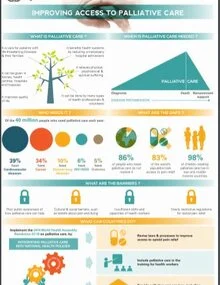
On Saturday October 9, 2021 the World Health Organization recognized World Palliative Care Day. Now what is palliative care and why does it matter? thewhpca.org/world-hospice-… #ph260720 #LeaveNoOneBehind
Many view palliative care as end-of-life care but it is so much more! Palliative Care treats suffering in both patients and families and should start at the beginning of care who.int/news-room/fact… #ph260720 #LeaveNoOneBehind
However, there is a HUGE challenge as only 1 in 10 people worldwide in need of palliative care, have access. That is right 1 in 10! We must do better! who.int/news/item/05-1… #ph260720 #LeaveNoOneBehind
So how do we do better? Barriers to improved access include lack of education in palliative care for both the public and healthcare professionals along with cultural barriers and insufficient access to opioids #ph260720 #LeaveNoOneBehind 

A special population in need is children with life-limiting illness. These children are particularly vulnerable to suffering and lack of access to care, but again many myths exist about children and death. #ph260720 #LeaveNoOneBehind icpcn.org/10-common-myth…
Sadly, for millions of children worldwide, they have limited access to palliative care. Specifically, close to 98% of children with palliative care needs live in LMICs thewhpca.org/resources/glob… #ph260720 #LeaveNoOneBehind
However, a study showed that 65% of countries worldwide had no pediatric palliative care provision at all. #ph260720 #LeaveNoOneBehind onlinelibrary.wiley.com/doi/10.1002/pb…
We must work to improve this by emphasizing education, policy, medicine availability, and thoughtful implementation #ph260720 #LeaveNoOneBehind 

Sadly, the COVID-19 pandemic has only exacerbated these issues as many palliative care teams have been furloughed or let go due to the pandemic. Up to 40% of palliative care professionals reported job loss due to the pandemic #ph260720 #LeaveNoOneBehind sciencedirect.com/science/articl…
What can you do to address this need? Please consider supporting organizations such as @ICPCN or @whpca that work diligently to address suffering around the world. #ph260720 #LeaveNoOneBehind icpcn.org
• • •
Missing some Tweet in this thread? You can try to
force a refresh



